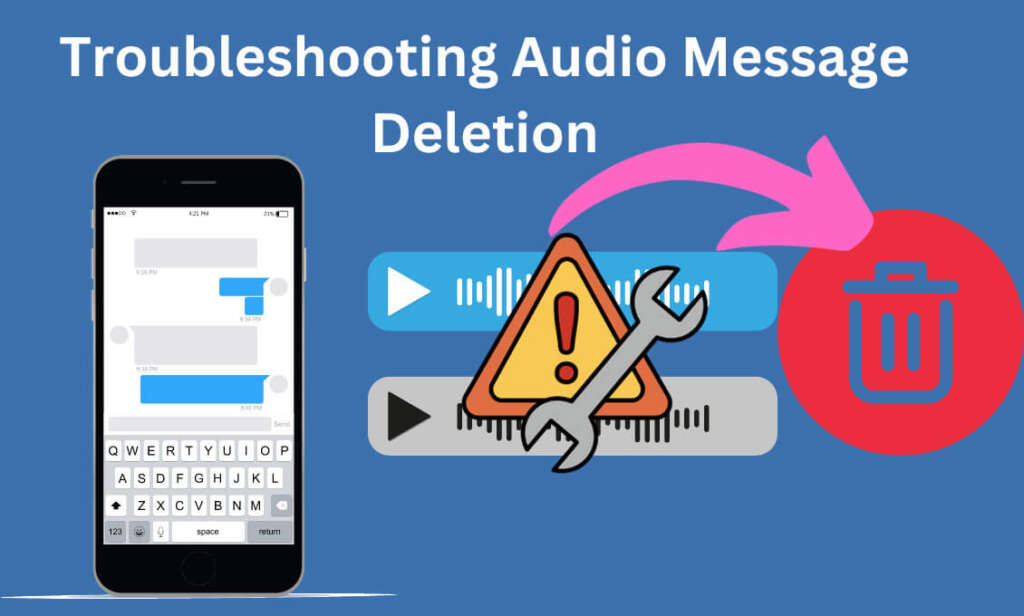To remove a kept audio message from your device, follow these steps: go to the message, tap and hold on the audio file, and select the option to delete it. Now, let’s dive into the details of how to remove a kept audio message from your device.
Sometimes, you may receive audio messages that you no longer need or want to keep. Whether it’s to free up storage space or declutter your device, deleting these audio messages can be a simple task.
In this post, We’ll guide you on how to remove kept an audio message from you, providing you with a clear and concise set of steps to follow. By the end, you’ll be able to easily delete any audio messages you want to remove, giving you more control over your device’s media storage.
List of Contents
- Archiving Audio Messages
- Backing Up Audio Messages
- Managing Audio Message Storage
- Deleting Audio Messages Permanently
- Understanding Audio Message Storage
- Locating And Deleting Audio Messages
- Troubleshooting Audio Message Deletion
- Best Practices For Audio Message Management
- Conclusion
- Frequently Asked Questions
Archiving Audio Messages
Archiving audio messages is a useful way to remove clutter and have a neat organization of your stored audio recordings. By archiving your audio messages, you free up space in your device without losing any important data.

Additionally, archiving allows you to protect and preserve your audio messages for future reference. There are different methods you can use to archive audio messages. One method is transferring the audio messages to an external hard drive or cloud storage.
This not only saves space on your device but also ensures that your audio messages are backed up and can be easily accessed from anywhere.
To organize your archived audio messages, you can create folders based on different categories or time periods. This makes it easier to find specific audio messages when needed. You can also label the folders with relevant information to provide a quick overview of the content.
Archiving audio messages offers several benefits such as saving storage space, ensuring data preservation, and improving accessibility. By implementing an effective archiving system and organizing your audio messages, you can streamline your digital files and have a convenient way of managing your audio recordings.
Backing Up Audio Messages
Backing up your audio messages is important for several reasons. Firstly, it ensures that you never lose any important or sentimental messages. Losing audio messages can be frustrating and heartbreaking, especially if they contain personal or sentimental content.
Backup Methods for Audio Messages
There are several methods you can use to back up your audio messages. One option is to use cloud-based storage services such as Google Drive or iCloud.
These services allow you to upload and store your audio messages securely in the cloud, ensuring that they are accessible from any device with an internet connection.
Another option is to manually transfer your audio messages to an external hard drive or computer. This method gives you full control over your backups and allows you to store your audio messages offline, keeping them safe from potential data breaches or cloud service outages.
Restoring Audio Messages from a Backup
When it comes to restoring audio messages from a backup, the process will vary depending on the backup method you choose. For cloud-based backups, simply log into your account and download the audio messages you want to restore.
For manual backups, connect your external hard drive or access the audio messages on your computer and transfer them back to your device.
By regularly backing up your audio messages and understanding how to restore them, you can ensure that you never lose any important or sentimental messages.
Take the time to establish a backup routine to protect and preserve your audio messages for years to come.
Managing Audio Message Storage
When it comes to managing audio message storage, there are a few options available. One way is to set storage limits for audio messages.
By doing this, you can control how much space these messages take up on your device. Another option is to automatically delete old audio messages.
This can be done by setting a time limit for how long these messages should be kept before being deleted. Additionally, you can also use third-party apps to manage audio message storage. These apps provide additional features and functionality for organizing and controlling your audio messages.
They offer options such as backup and restore, selective deletion, and more. In conclusion, managing audio message storage is essential to keep your device running smoothly and avoid storage issues.
By setting storage limits, deleting old messages, and using third-party apps, you can easily manage and organize your audio messages.

Credit: www.google.com
Deleting Audio Messages Permanently
The risks of permanently deleting audio messages:
| Risks | Solution |
|---|---|
| Unintentional deletion | Double-check before deleting audio messages to avoid accidental removal. |
| Data recovery | Even after deletion, deleted audio messages can sometimes be recovered using data recovery software. Ensure secure deletion methods are used to prevent retrieval. |
| Loss of valuable information | Permanently deleting audio messages without backing up important information can lead to irretrievable loss. |
Ensuring all traces of audio messages are removed:
To guarantee the complete removal of audio messages, follow these steps:
- Review and identify the audio messages you want to delete.
- Back up any important data or information stored within the audio messages.
- Permanently delete the audio messages, utilizing a secure deletion method.
- Empty your trash or recycle bin to ensure the audio messages are not recoverable.
Using secure deletion methods for audio messages:
Consider employing the following methods to securely delete audio messages:
- Overwriting: Use software that overwrites the data multiple times to make it unrecoverable.
- Encryption: Encrypt the audio messages before deletion to enhance security.
- Physical destruction: Physically destroy the storage medium (if applicable) to ensure complete removal.
Understanding Audio Message Storage
Audio messages are stored on your device in various formats and locations, which can affect the overall performance of your device. The storage location of audio messages depends on the platform you are using.
For example, on iOS devices, audio messages are stored within the Messages app, while on Android devices, they are stored in the WhatsApp media folder or other messaging apps.
These audio messages are typically saved as .m4a or .wav files and are stored either on the internal storage of your device or on an external SD card. The storage of these audio files can quickly accumulate and consume valuable storage space on your device.
This can lead to decreased device performance, as the storage space used by audio messages may restrict the device’s ability to install new apps, capture photos or videos, or perform other essential functions.
It’s important to regularly manage and delete unwanted audio messages to free up storage space and optimize the performance of your device.
Locating And Deleting Audio Messages
Locating and deleting audio messages is a task that can vary depending on the device you are using. Whether you are using an iOS or Android device, accessing your audio messages through your messaging app is pretty straightforward.
In iOS, you can find your audio messages within the specific conversation by tapping on the contact’s name and then selecting “Info” or “Details.” On Android devices, audio messages are often located within the chat thread itself.
To remove audio messages, you can simply select the individual message you want to delete and look for the delete option. This process can differ based on the messaging app you are using, but it is typically denoted by a trash can or delete icon.
By selecting this option, you can remove the audio message from your chat history and free up storage space on your device. Remember, the steps mentioned here may vary slightly depending on the device and messaging app you are using.
Nevertheless, locating and deleting audio messages is generally a simple process that allows you to manage your messaging app effectively.
Troubleshooting Audio Message Deletion
Troubleshooting audio message deletion can sometimes be a challenging task for users. There are common issues that may arise when attempting to remove kept an audio message from your device.
Some potential problems include unavailable delete options, error messages, or the message simply not deleting. To troubleshoot these issues, follow these steps:

- First, ensure that you have the latest version of your messaging app installed. Oftentimes, software updates include bug fixes and improvements that can address deletion problems.
- Check your device’s storage space. Insufficient storage can prevent audio messages from being deleted. Clearing up some space might resolve this issue.
- If you are unable to delete a specific message, try to force quit the messaging app and reopen it. Sometimes, this simple action can resolve temporary glitches that prevent deletion.
- Restart your device. A simple restart can fix many software-related issues, including problems with audio message deletion.
If you have tried these troubleshooting steps and are still facing issues, it may be time to consider seeking professional help. Reach out to the app developer’s support team or consult with an expert who specializes in the specific messaging app you are using.
They will be able to provide personalized solutions and guidance to address your audio message deletion problems effectively.
Best Practices For Audio Message Management
Proper management of audio messages is crucial to maintain a clutter-free and organized space. Here are some tips to optimize audio message storage:
| Ensure Privacy and Security: | Protecting sensitive audio messages is paramount. Implement strong security measures, such as encryption, to prevent unauthorized access to your audio files. |
| Keep a Backup Plan: | Always have a reliable backup plan in place. Regularly back up your audio messages to an external storage device or a cloud-based platform to avoid data loss in case of device failure or accidental deletion. |
By following these best practices, you can effectively manage your audio messages, safeguard your privacy, and ensure the availability of important audio content whenever you need it.
Conclusion
To sum it up, removing a kept audio message is a simple task that can be done in just a few steps. By following the methods mentioned in this blog post, you can easily delete unwanted audio messages from your device.
Remember to back up your important messages before making any changes. With these simple yet effective techniques, you can quickly free up space and maintain a clutter-free audio message collection.
Frequently Asked Questions
How Can I Remove An Audio Message From My Device?
To remove an audio message from your device, open the messaging app, locate the audio message, and press and hold on to it. Then, select the option to delete or remove the audio message from your device. Confirm the action to complete the removal process.
Can I Retrieve A Deleted Audio Message?
Unfortunately, once you have deleted an audio message from your device, it cannot be retrieved. It is important to keep this in mind before deleting any important audio messages. Make sure to double-check before deleting to avoid permanently losing any valuable messages.
Why Is It Important To Remove Audio Messages From My Device?
Removing audio messages from your device helps free up storage space, keeping your device running smoothly and efficiently. It also helps maintain your privacy by ensuring that sensitive or confidential audio messages are not accessible to others who may have access to your device.
Are There Any Alternative Methods To Remove Audio Messages?
Yes, apart from manually deleting audio messages, you can also consider using third-party apps or software that specialize in managing and deleting audio messages. These tools can provide additional features and convenience in managing and organizing your audio messages. Be sure to research and choose a trusted and reliable option.










